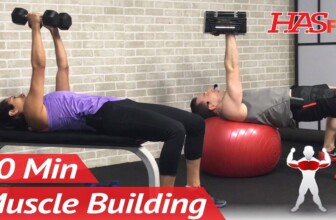5 exercises to STRENGTHEN arthritic knees WITHOUT more pain
Increase strength without increasing pain ✅
If you have difficulty finding ways to build strength when dealing with arthritic knee pain, I have the exercises just for you. As a physical therapist specializing in helping those with osteoarthritis, these continue to be the top 5 ways to get stronger knees without flaring up pain.
Research continues to show that muscle strengthening is imperative for knee osteoarthritis relief and can bring powerful results. The key is finding movements that actually feel good. Whether you are just starting out on your fitness journey or have experience- this video will give you options to work on for stronger knee flexors and knee extensors- both equally important for relief.
With knee osteoarthritis, it is important to listen to your body and progress gradually. Progressing too quickly can lead to increased pain and increased difficulty with mobility.
Product links 🛍️
Step stool link: https://amzn.to/44Jx1om
Patio chair link: https://shorturl.at/pBDY1
Videos you may like 👀
10 squat modifications: https://youtu.be/dCn7YpXFHC0
How to reduce knee stiffness after sitting: https://youtu.be/7dcrc7vg-4Y
Gentle workout for bone on bone knees: https://youtu.be/-Q68eY9k5Ps
Join the Adventurers for Life membership: https://keeptheadventurealive.com/start
Follow us on social media:
Website: https://keeptheadventurealive.com
Facebook: https://www.facebook.com/adventurealive
Private Facebook Group: https://www.facebook.com/groups/adventurealive
Instagram: https://www.instagram.com/adventurealive/
Pinterest: https://www.pinterest.com/adventurealive/_created/
Subscribe to our YouTube channel: https://www.youtube.com/alyssaadventurealive
Podcast: https://osteoarthritis.buzzsprout.com
Disclaimer: This video is for general informational purposes only. It should not be used to self-diagnose and it is not a substitute for a medical exam, cure, treatment, diagnosis, and prescription or recommendation. It does not create a doctor-patient relationship between Dr. Kuhn and you. You should not make any change in your health regimen or diet before first consulting a physician and obtaining a medical exam, diagnosis, and recommendation. Move Well Age Well, LLC and Dr. Alyssa Kuhn, PT, DPT are not liable or responsible for any advice, course of treatment, diagnosis or any conclusions drawn, services or product you obtain through this post, video or site. Complete all exercises at your own risk.
odds are you've spent time scouring all the information out there to answer one question how can I find arthritic pain relief without surgery and trust me You Are Not Alone In searching for options that don't involve more medications more injections more procedures or surgeries and you do actually have options when it comes to pain relief and one of those options is getting strong muscle strengthening can be extremely powerful when it comes to providing arthritis pain relief and opening the doors to an active lifestyle don't just take my word as physical therapist for it it has been extensively studied in the research how truly powerful this can be in this video we're going to go through my top five favorite movements to help strengthen your arthritic knees in the right places to bring you relief we're going to start with the most basic and then they're going to increase in difficulty so make sure you stay till the end so you know what you're going to be working towards here we go for this first exercise you're going to start in a seated position even if you feel you are beyond the basics I would highly encourage you just to try these basic movements first to make sure that you are on the right track for each of these movements I'd like you to be able to comfortably complete around 20 repetitions before moving on to the next exercise starting in a seated position what I'd like you to do is scoot to the edge of the chair where both feet are able to be on the floor we're going to be working the thigh muscles these are also called the knee extensors very important for walking and for stair climbing you're going to kick one leg out and then the other now notice I am straightening my leg which is working the knee extensors the straighter you go the more you're going to be working this muscle if you have a hard time doing that because of pain or weakness what you can do is bring your heel and just tap it out in front of you notice you're still straightening your legs so you're still working this muscle but your goal is to be able to work up to here where now you're working those muscles a little harder but of course we don't want to flare up pain now again you want to work to about 20 repetitions that you can do comfortably without flaring up pain before moving on to the next one exercise number two is going to be in standing now it's not only important to work the thighs or the knee extensors that we just talked about but you also want to work the knee flexors the muscles that help to bend the knee those knee flexors are actually in the backs of your legs and these tend to get neglected we don't tend to work these as often as the thighs so this exercise we're going to directly work on those knee flexors what you're going to do you can use support if you need it you're going to start on one side so I'm going to stay on stay on my right side and I'm going to bend up my left heel so think about this muscle working to bring your heel up to bend that knee I like to call these heel lifts and a lot of times you can really feel in the back of your leg pretty quickly if you do experience some cramping it is normal and that means that muscle really needs to be worked on what you can do is try not to lift so high and really try to just get some activation here first the higher you lift your leg the more that muscle has to work I would shoot for about 20 repetitions on one side and then 20 repetitions on the other side before moving on to the next movement exercise number three is a chair squat now before you say oh this hurts there's no way I can do it I'm gonna show you a trick okay now remember for each movement you want to master about 20 repetitions so if you're not there yet for the chair squat that's okay that is a goal for you to work towards this is arguably one of the most important movements to master if you have knee arthritis I want to break the movement down just for a moment so it starts to make a little more sense why it's so important now for a chair squat essentially you're starting in a seated position and then going into standing watch what my knees are doing and think about those two muscle groups that we just talked about the knee extensors the ones that straighten the knee and then the knee flexors the ones that bend the knee as I go to stand up all I'm essentially doing is trying to straighten my knees as I sit down I'm trying to do a controlled bending so I don't plop down if you have a hard time standing up you may need more work in those knee extensors those thigh muscles if you have a hard time sitting down you may need some work in those knee flexors unlikely a combination in the thighs as well the sitting down in a controlled fashion is the harder part of this movement as you stand up you're using those thighs to try to extend or straighten your knees so a simple chair squat is essentially standing up and then sitting down and I want to caveat this with sitting down in a controlled fashion to get the most out of this movement you must be able to do the first half which is standing up and the second half sitting down without plopping one way that you can help to change this movement if you are experiencing pain with this or even if you're not and you want to add a little bit more core work to this movement all you need is a pillow now this pillow it just needs to be big enough that you can hold on to it what you're going to do is just place it on your knees as you stand up or just hold it near your chest you're mainly going to be using this as you sit down as I sit down I'm going to press the pillow out in front of me and then I'm going to stand up and press the pillow out in front of me what this is doing is allowing you or basically requiring you to push your hips back this is one of the biggest mistakes I see as a physical therapist so many people when they sit down they bend the knees first whatever joint bends first takes most of the load so if you add a pillow to this you're essentially forcing your hips to bend first your hips are much more prepared to take more of the load than your knees are without the pillow you might find yourself doing almost like a little scrunch to sit down instead I want you to focus on that pillow pushing that pillow out as you sit down and standing up pushing that pillow out to use more of those hips hip strengthening is incredibly important for knee arthritis relief as well so we can't just look at the muscles of the legs near the knee we have to actually look up at the hips too the great thing about this movement in particular is you are working so many different muscles at once I do have a video on 10 squat modifications that even with the pillow if you start to experience some pain you can check out that video as well or if you're just curious on how to add variety to a chair squat that is a great video to go to exercise number four can be very helpful if you're working towards getting better at stairs but make sure that you have mastered the three previous first this exercise becomes a little bit more challenging because we're going to start working on Single Leg strengthening so this may highlight if you have one side that's stronger than the other for this exercise you'll need a step stool or you will need the bottom step of a flight of stairs I really like another tip to use a step stool when I'm doing any sort of stair work or practicing on getting stronger for stairs a lot of times stairs can be I believe they're around eight inches on average but sometimes stairs can be really hard especially as you're working towards strengthening getting a mini step stool like this really gives you more options and allows you to build up that strength without flaring up your pain this is a mini aerobic step stool I'll put a link down below it's just from Amazon but I also like it because you can adjust it so you can take the bottom Riser off and make it even smaller I think it's around four inches and then six inches when it's when the risers are in so just a caveat what you're going to do is I'm going to put one foot on top so let's say I'm going to start with my left foot then I'm going to hop my right foot back so that there is a distance maybe between one to two feet between your front foot and back foot make sure your step stool is on a surface that it's not going to slide out from underneath you this exercise is going to work again multiple muscles at once and we'll see why here in a second what you're going to do is Bend both knees that back heel can come up it does not have to stay on the ground Bend both knees slightly and then push away knee flexion bending those flexors are working the backs of your legs as I push back my extensors are working those thighs right in the fronts of those legs lunges can be really difficult if you have knee arthritis and are a common source of pain for a lot of people doing it in this front foot elevated lunge allows me to keep in control of this front knee and start to work on the movement if you watch my knee in regards to my toe my knee stays fairly in line with my ankle here and stay slightly behind the toes the problem with a lot of typical lunges is you tend to bring your knee towards your toe now this is not an inherently dangerous position and this isn't certainly a position that you should avoid for the rest of your life but if you are currently experiencing knee pain as your knee gets closer to your toe it's likely not going to feel comfortable especially at first but you need to get there in order to especially go downstairs so this is a way to help you start to build up that tolerance I'm just going to bend both knees and then push away Bend both knees and push away the beauty of this is your hips are also working as well remember we don't want to neglect those again we're aiming for about 20 repetitions on each side now please work up to this and do not try all 20 at once try five each side see how you feel bump it up to 10 each side and see how you feel this is all about gradual working towards a goal then you will switch sides and you will do the same thing this will also challenge balance as well once you're able to master 20 on each side you can move on to exercise number five now exercise number five is actually a balance exercise which you may not think that balance and strength go hand in hand butt balance can help improve strength and I'll explain why in a second but first I want to get you set up for this movement now you may notice I'm in the corner of a wall this is another hack if you're practicing balance movements at home is to do it in the corner of a wall so that way if you do lose your balance you have support on three sides of you both sides and then behind that way it helps to improve the safety because that is of utmost importance you're going to need a weighted object so you can use a dumbbell or you can use a soup can or a water bottle and fill it with water I'd find something that's about five pounds or less especially if this is the first time you're trying this movement what you're going to do is put one foot in front of the other ideally you want one foot directly in front of the other that's the hardest variation of this movement but if you need to you can widen your feet to give you a wider base of support that will make the balance a little bit easier once you find a position where you're able to stand here for about 10 seconds pretty comfortably without feeling super wobbly what I would like you to do now is pass the dumbbell back and forth or past the weighted object back and forth what this is doing is making your body stabilize as you shift your weight side to side this again is a movement that commonly gets neglected as you're primarily moving forward you don't challenge the loss of balance laterally a lot but it is so incredibly important now when you're doing this I want you to think or maybe even feel what your leg muscles are doing what your hip muscles are doing do your muscles start to get tired when you do this the answer should be or maybe yes depending on how proficient you are at balance when you are balancing all of your muscles are working at once to help to support your joints to help to support your knees and to help to support your hips one way to ensure those muscles are active is to not lock your knees out keep them slightly bent so they are active also think about keeping your weight towards your heels that's going to make the backs of your legs and even your glutes or your butt muscles active as I'm doing this my muscles are working to keep my legs strong and stable so they don't give out or I don't lose my balance then I'm going going to switch the position of my feet and repeat I like to count this 20 passes on one side and then 20 passes on the other side now remember the position to work towards is one foot directly in front of the other now it's your turn to actually see the power that getting stronger has over knee arthritis pain relief listen to your body gradually work into these movements especially if they are newer movements don't try to do too much too quickly or you will pay for it give yourself time be patient and start building up those muscles to support your knees if you know somebody else who is dealing with knee pain and looking for Relief share this video with them it is time to open the doors to Adventure even with arthritis
#exercises #STRENGTHEN #arthritic #knees #pain
source











I’m 68 and don’t want or believe in a knee replacement. Thank you 😊
I had clicking knees and sharp, knife in the knee pain. Started taking 400 g of magnesium for better sleep and some muscle spasms and the pain went away. 😊 Took 2 months to reverse magnesium deficiency. If I missed a dose pain would return almost immediately in the first month.
Doctor wanted to put jelly substance in my knees to stop pain. (I have low cartilage in the knees) I had to repeat to him that using magnesium stops the pain. Several times. It’s like he is completely hypnotised or brainwashed. Has said I will need knee replacement. I will see him again this time in 2026 to see if magnesium, gelatine and a carnivore diet will build my knee cartilage.
This vid is great if you don’t have pain. I will be very careful doing these exercises. Now that I can. 😁
Can I do these if I have one total knee replacement?
You are an excellent instructor!
thanks, helpful
These Exercises are Not new…on utube .They are al the same 😊
Excellent advice to help the pain & strengthen the knee to hopefully prevent knee replacement. A really good instructor. 😊
The Doctor advise me the gel injection. Is more expensive this is the result of my MRI
left knee
Osteoarthritic changes with osteochondral lesions and minimal marrow edema in the lateral femoral
condyle and small osteochondral lesion in the medial patellar facet.
Minimal joint effusion.
Small ganglion cyst in the posterior aspect of the lateral femorotibial joint.
Medial meniscal tear.
Subcutaneous edema is in the anterior knee.
Right knee
Osteoarthritic changes with osteochondral lesions and minimal marrow edema in the medial patellofemoral
joint.
Minimal joint effusion.
Medial meniscal tear.
Minimal subcutaneous edema surrounding the knee.
GEMMA ROSA
Thank you SO much. Fantastic video well demonstrated and I loved the explanations to explain as well. May I ask I use a tight stretch bandage knee support as it really hurts If I don't, especially walking and bending.. Shall I use this knee support when I do exercises please or would you rather I didn't please as I am not sure what to do? Thanks for your time.Nataie from England 😁😁
You are awesome Alyssa,thank you for taking time for training us
From California
Vio
Like video. But tend to think you are talking slow because you think we are slow? Playing at 2x speed makes it bearable.
❤❤❤❤❤❤❤❤❤❤❤❤❤❤
Alyssa, thank you, for work and ministry!❤🎉😢😮😮😅😊
These are fantastic, thank you!
Thank you for all the great and needed information (especially helpful for bone on bone exercises) that I do outside of the gym and your kind spirit. By the way, you have great legs!😊
I NEVER had knee pain until I started squats. Now I'm in constant pain
Alyssa, thanks for all your posts. I appreciate your explanations and your presentations. Very well and clearly done. Keep it up!
is it ok to do vertical siccors w the legs with bands above the knees while lying on ur back? ive not seen this motion in ur videos
Thank you for this gentle approach to knee wellness. I will continue at home with your support, as well as maintain aqua therapies 3x week in a heated pool. Getting better each day! No need for surgery if I keep it up!
Very valuable. I have had great PTs work with me and have a couple of favorite PTs I watch online. You are OUTSTANDING. Many thanks!
Would it be beneficial to use weight machines using 5 to 10 pound weights?
Excellent video ! Thanks
I am on limited income, so. I just use big books to step on (to keep them from being slippery I wrap them in saran wrap)
Thanks for this video.Well presented and I found these exercises were so beneficial and look forward to doing these daily.Thanks so much.😊
exercises to STRENGTHEN arthritic knees WITHOUT??